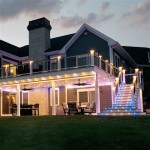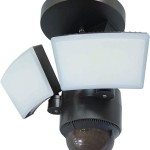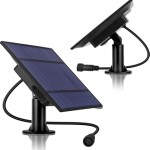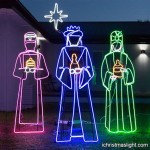Motion Sensor Lights: Outdoor Installation Guide
Outdoor motion sensor lights offer a valuable combination of security, convenience, and energy efficiency for residential and commercial properties. These lights automatically activate when movement is detected within their sensor range, illuminating pathways, deterring potential intruders, and conserving electricity by remaining off when not needed. Properly installing motion sensor lights is crucial for optimal performance and longevity. This article provides a comprehensive guide to outdoor motion sensor light installation. It covers pre-installation considerations, step-by-step installation instructions, troubleshooting common issues, and essential maintenance tips.
Planning and Preparation
Before beginning the installation process, careful planning and preparation are essential. This stage ensures that the correct equipment is available, the installation area is safe, and the lights will function as intended.
The first step is to determine the ideal location for the motion sensor lights. Consider the areas that require illumination for security or convenience, such as driveways, walkways, patios, and entry points. The sensor's field of view should encompass the target area without triggering unnecessarily on passing traffic or wildlife. Take into account the sensor's detection range and adjust the location accordingly. Many motion sensors have adjustable sensitivity settings that may alleviate issues with false triggers, but optimal placement is still paramount.
Next, assess the existing electrical infrastructure at the chosen location. Determine if there is an existing outdoor light fixture that can be replaced with a motion sensor light or if new wiring needs to be installed. If there is an existing fixture, ensure that the electrical box is properly rated for outdoor use and is structurally sound. If new wiring is required, it may be necessary to consult with a qualified electrician to ensure compliance with local electrical codes.
Based on the location and wiring assessment, select the appropriate type of motion sensor light. There are several types available, including floodlights, spotlights, and decorative fixtures. Consider the desired brightness, beam spread, and aesthetic appeal when making your selection. Ensure that the light fixture is specifically designed for outdoor use and is rated for the expected weather conditions in the area. The IP (Ingress Protection) rating is a good indicator of the fixture's resistance to water and dust.
Gather the necessary tools and materials. This typically includes a ladder, screwdriver set (including both Phillips head and flathead screwdrivers), wire strippers, wire connectors (wire nuts or push-in connectors), electrical tape, a voltage tester, safety glasses, and work gloves. If new wiring is required, additional tools such as a drill, fish tape, and conduit may be necessary. Ensure all tools are in good working condition and are appropriate for electrical work.
Safety is paramount when working with electricity. Before beginning any electrical work, turn off the power to the circuit at the main electrical panel. Use a voltage tester to verify that the power is indeed off before touching any wires. Never work on electrical systems in wet conditions or without proper safety equipment.
Step-by-Step Installation Process
Once the planning and preparation are complete, the installation process can begin. The following steps provide a general guide, but always refer to the manufacturer's instructions for specific recommendations relevant to the chosen light fixture.
Begin by removing the existing light fixture, if applicable. Carefully disconnect the wires, noting the color coding of each wire. Typically, black is the hot wire, white is the neutral wire, and green or bare copper is the ground wire. Use electrical tape to label each wire to avoid confusion during re-installation. Ensure the power to the circuit is off before disconnecting any wires.
If installing new wiring, run the appropriate gauge wire from the electrical panel to the desired location, following local electrical codes and regulations. Use conduit to protect the wire if it is exposed or buried underground. Secure the wire to the electrical box using a cable clamp to prevent strain on the connections.
Mount the motion sensor light fixture to the electrical box. Ensure that the fixture is securely attached and properly aligned. Use the provided mounting hardware and follow the manufacturer's instructions. The light fixture should be weather-resistant and sealed to prevent water from entering the electrical box.
Connect the wires from the light fixture to the wires from the electrical box, matching the color coding. Connect the black (hot) wire from the fixture to the black wire from the electrical box. Connect the white (neutral) wire from the fixture to the white wire from the electrical box. Connect the green or bare copper (ground) wire from the fixture to the green or bare copper wire from the electrical box or to the grounding screw in the electrical box. Use wire connectors to create secure and insulated connections. Wrap the connections with electrical tape for added protection.
Carefully tuck the wires into the electrical box, ensuring that they are not tangled or pinched. Install the light bulb and any decorative trim or covers that came with the fixture. Follow the manufacturer's instructions for installing the light bulb. Ensure that the bulb is compatible with the fixture and is properly seated in the socket.
Restore power to the circuit at the main electrical panel. Test the motion sensor light to ensure that it is functioning properly. Adjust the sensor's sensitivity and range settings as needed to achieve the desired performance. Most motion sensors have adjustable settings for sensitivity, time-on duration, and daylight shutoff. Experiment with these settings to optimize the light's performance for the specific location and needs.
Troubleshooting and Maintenance
After installation, it is important to regularly maintain the motion sensor lights to ensure optimal performance and longevity. Address any issues promptly to prevent further damage or safety hazards.
One common problem is the light turning on and off repeatedly, even when there is no apparent movement. This can be caused by several factors, including: improper sensitivity settings, nearby moving objects (such as trees or bushes), or electrical interference. Adjust the sensor's sensitivity settings to reduce the likelihood of false triggers. Trim any vegetation that may be triggering the sensor. Check for any sources of electrical interference, such as nearby radio transmitters or power lines.
If the light does not turn on at all, check the following: the light bulb is not burned out, the power to the circuit is turned on, the wiring connections are secure, and the sensor is not set to daylight shutoff. Replace the light bulb with a new bulb of the correct type and wattage. Verify that the circuit breaker is not tripped. Inspect the wiring connections for any loose or damaged wires. Ensure that the sensor is not set to daylight shutoff mode during nighttime hours.
If the light stays on continuously, check the following: the sensor is not damaged, the time-on duration is not set too long, and there is no constant movement within the sensor's range. Inspect the sensor for any signs of physical damage. Reduce the time-on duration setting to a shorter period. Ensure that there is no constant movement within the sensor's range, such as a flag waving in the wind.
Regularly clean the lens of the motion sensor and the light fixture to remove any dirt or debris that may be affecting its performance. Use a soft cloth and mild detergent to clean the lens and fixture. Avoid using abrasive cleaners or solvents, as these can damage the surface.
Inspect the wiring and connections periodically for any signs of damage or corrosion. Replace any damaged wires or connectors promptly. Apply a corrosion inhibitor to the connections to prevent future corrosion. If any significant electrical issues are detected, consult with a qualified electrician.
By following these installation, troubleshooting, and maintenance guidelines, property owners can ensure that their outdoor motion sensor lights provide reliable security, convenience, and energy efficiency for years to come. Proper installation and regular maintenance are crucial for maximizing the benefits of these devices and ensuring the safety of the property and its occupants.

Motion Detector Lights All You Need To Know About Them Kato Electrical Independent Contractor Vancouver Bc

The Best Outdoor Motion Sensor Lights In 2024 Popular Science

Philips Hue Outside Motion Install Senex Home Security And Automation

Install Motion Sensor Lighting For Elderly Homeowners Mr Handyman

Lightdot Led Security Lights Motion Sensor Light Outdoor 38w 3800lm O

Le Solar Flood Lights Outdoor Motion Activated Security A Cost Effective And Eco Friendly Way To Improve Your Home O Gadgets Limited

How To Install An Outdoor Motion Sensor Light With Pictures

Discover The Benefits Of Outdoor Motion Sensor Lights Staysafe Org

Motion Sensor Lights Tips To Reset Detector

Fixr Com Cost To Install Outdoor Motion Sensor Lights
Related Posts







